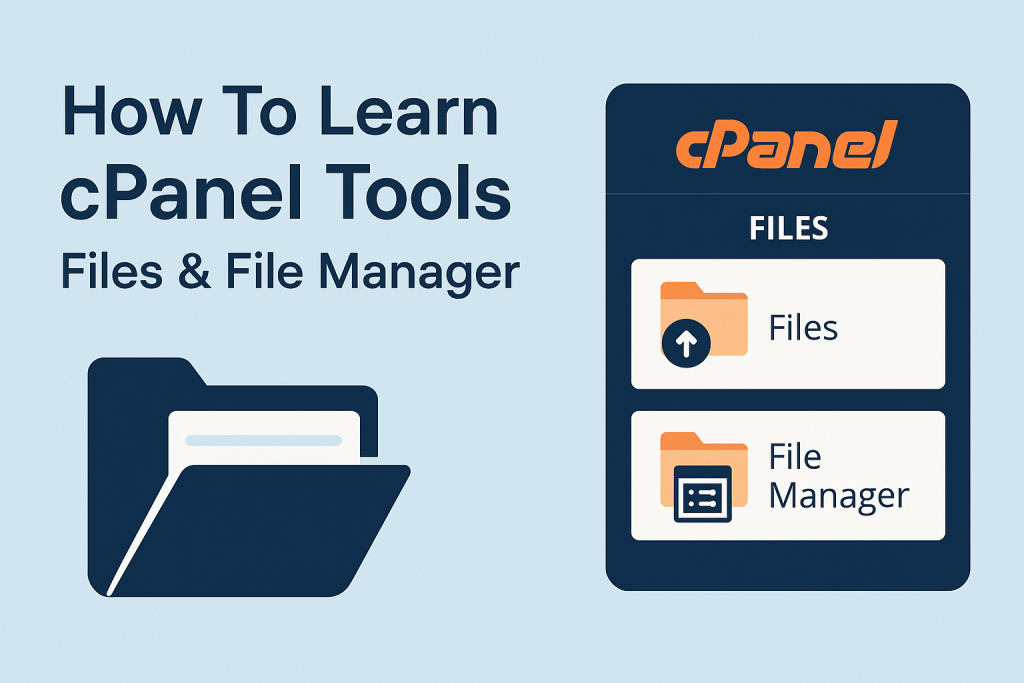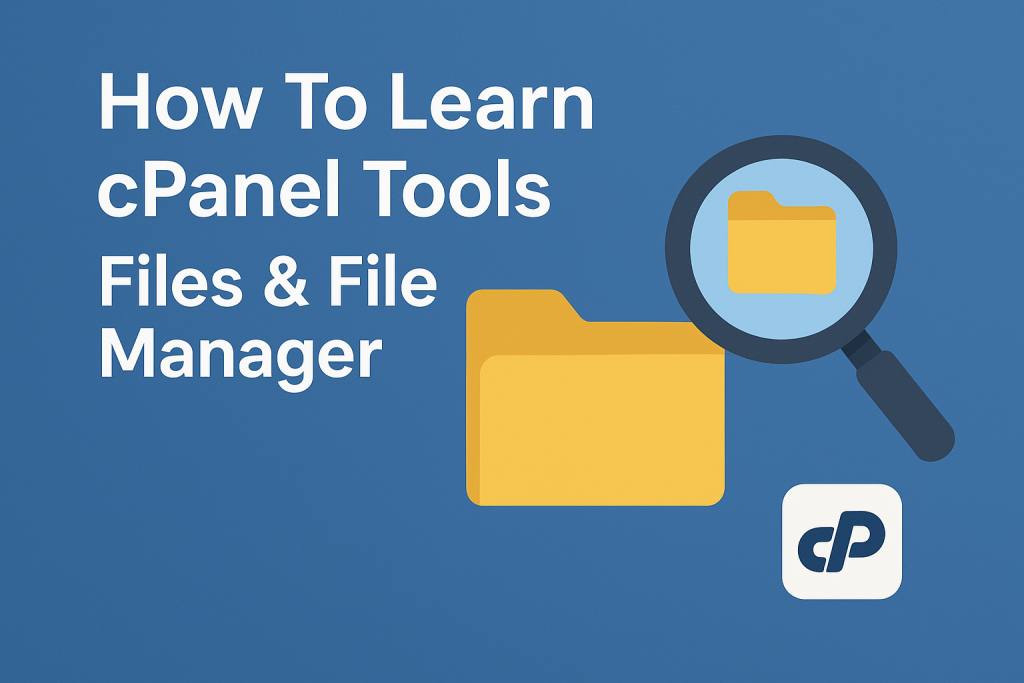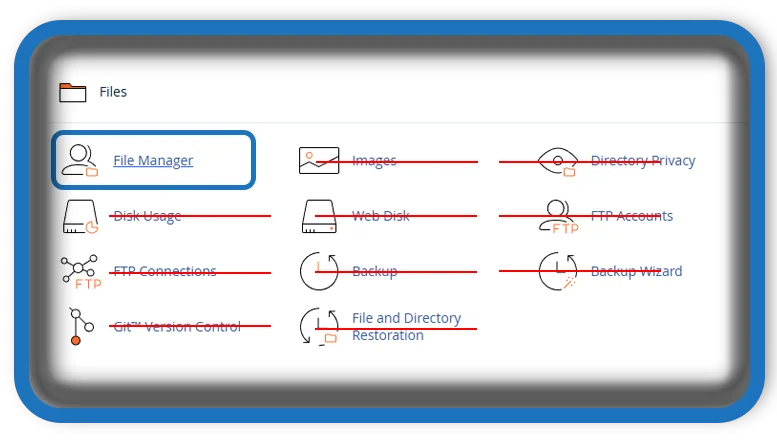⏲️ Estimated reading time: 5 min
cPanel Tools: Files & File Manager Explained. cPanel offers essential tools for managing website files with ease. The File Manager in particular allows you to upload, edit, and organize your files without needing FTP. This guide covers all key features of cPanel’s file management tools.
Introduction to cPanel File Manager Tools
cPanel is one of the most popular control panels for web hosting. It simplifies website and server management, especially for non-technical users. Among its many functionalities, File Manager stands out as a central tool for managing files directly from the web interface no FTP clients or terminal commands required.
In this guide, we’ll walk you through everything you need to know about the Files section in cPanel, including the File Manager, Images, Directory Privacy, Disk Usage, and other helpful tools.
The “Files” Section in cPanel: What’s Inside?
When you log in to your cPanel dashboard, you’ll find a section labeled “Files”. Here are the key tools you’ll find:
- File Manager
- Images
- Directory Privacy
- Disk Usage
- Web Disk
- Backup & Backup Wizard
Each tool serves a different purpose, but together they give you complete control over your website’s file system.
File Manager: The Powerhouse Tool
The File Manager in cPanel functions like a file explorer for your website. It allows you to:
- Navigate your site’s directories
- Upload and download files
- Edit HTML, CSS, PHP, or TXT files directly
- Move, copy, rename, and delete files
- Extract and compress archives (.zip, .tar.gz)
- Set permissions (CHMOD) for files and folders
How to Access cPanel File Manager
- Log in to your cPanel account.
- Scroll down to the Files section.
- Click on File Manager.
By default, File Manager opens the home directory, but you can choose to start in the public_html folder, which is the root for your website content.
Using cPanel File Manager: Step-by-Step
1. Uploading Files
Click the Upload button in the top toolbar. You’ll be prompted to select files from your computer. Once uploaded, the files are immediately available on your website (if uploaded to public_html).
2. Editing Files
You can click any file and choose Edit or HTML Editor from the top menu. This is useful for making quick updates to configuration files, PHP scripts, or webpage content.
3. Creating Files & Folders
Use the + File or + Folder buttons to organize your content better.
4. Moving and Copying Files
Right-click or use the toolbar to move or copy files from one folder to another, such as from a staging environment to live.
5. Permissions
You can change file permissions by selecting the file and clicking Permissions. This is important for securing scripts and folders.

Images Tool in cPanel
The Images tool helps manage your images through three built-in utilities:
- Thumbnailer: Creates thumbnail versions of your images.
- Scaler: Resize images while maintaining aspect ratios.
- Converter: Change file formats (e.g., PNG to JPG).
These are especially useful if you’re working with media-heavy websites.
Directory Privacy (Password Protection)
With Directory Privacy, you can:
- Password-protect directories
- Control access to sensitive areas like
/adminor/private
To set it up:
- Click on Directory Privacy.
- Choose a folder (e.g.,
/admin). - Enable protection and set username/password.
Only users with credentials can access the protected folder.
Disk Usage Tool
The Disk Usage tool provides a visual and tabular summary of how much space your files are using. It’s particularly useful for:
- Identifying large files or folders
- Cleaning up unnecessary backups or error logs
- Monitoring your storage limits on shared hosting
Web Disk
The Web Disk feature allows you to map a folder from your server as a network drive on your local computer. It’s like connecting your site’s files as if they were a USB drive:
- Available on Windows, macOS, and Linux
- Supports drag-and-drop file operations
You need to set up a Web Disk account via cPanel and configure your OS with the provided settings.
Backups & Backup Wizard
Though not part of the File Manager itself, the Backup and Backup Wizard tools let you download:
- Full website backups
- Partial backups (Home directory, MySQL databases, Email forwarders)
They’re critical before making big file changes. You can also upload backups if you need to restore your site.
Tips for Using cPanel File Manager Safely
- Always back up before editing core files.
- Use the HTML Editor for live HTML previews.
- Set permissions carefully avoid 777 unless absolutely necessary.
- Avoid editing
.htaccessorwp-config.phpunless you know what you’re doing. - Use search (top right) to quickly find files.

Conclusion
The cPanel File Manager is a versatile, beginner-friendly tool that makes file handling straightforward. From uploading your website files to editing, securing, and managing storage, everything is just a click away. Combined with the other tools in the Files section, cPanel offers full control over your hosting environment even if you don’t touch FTP or SSH.
If you’re new to hosting or just want an easier way to manage your site, getting comfortable with File Manager is a great first step.
🏷️ Tags: cpanel, file manager, web hosting, website management, file upload, directory privacy, disk usage, web disk, image tools, file permissions
Only logged-in users can submit reports.
Discover more from HelpZone
Subscribe to get the latest posts sent to your email.

